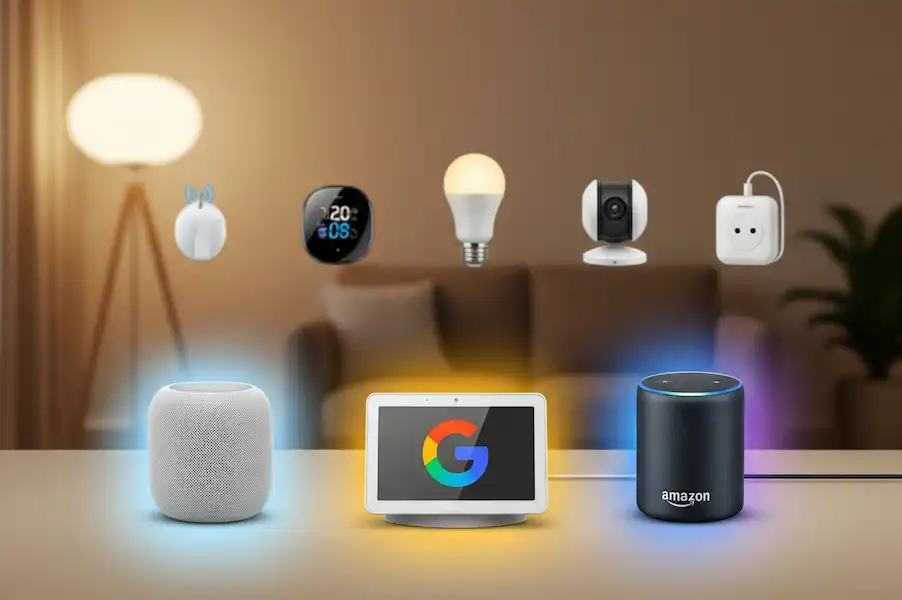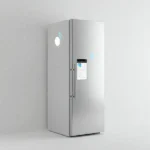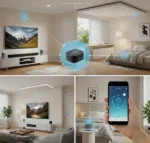Setting Up Your Smart Home Ecosystem: Apple HomeKit vs. Google Home vs. Amazon Alexa – A Comprehensive 2025 Comparison
Choosing a smart home ecosystem is a foundational decision that will shape your entire connected living experience. In 2025, while the Matter standard aims to bridge some compatibility gaps, the core differences in privacy, device selection, user experience, and underlying philosophies still make this decision crucial.
This guide, built on extensive research and a practical understanding of smart home technologies, will help you navigate the options and make an informed choice for your household.
The Contenders: Apple HomeKit, Google Home, and Amazon Alexa
Let’s break down each platform, examining their strengths, weaknesses, and ideal user profiles:
1. Apple HomeKit (and Siri)
- Core Philosophy: Privacy, security, and seamless integration for existing Apple users. Apple’s approach emphasizes a tightly controlled environment to ensure reliability and user data protection.
- Voice Assistant: Siri (accessible via HomePod, HomePod mini, iPhone, iPad, Apple Watch, and Mac).
- Key Strengths:
- Unrivaled Privacy and Security: This remains Apple’s paramount focus. HomeKit prioritizes local control for many devices, meaning commands are often processed directly within your home network (e.g., on a HomePod or Apple TV acting as a home hub) rather than always relying on cloud servers. Features like HomeKit Secure Video offer end-to-end encryption for camera footage, ensuring your video streams are private and not accessible by Apple. Voice recordings are generally processed on-device or anonymously, minimizing data collection. This is a significant differentiator for privacy-conscious users.
- Intuitive User Experience for Apple Devotees: If you’re already deeply invested in the Apple ecosystem, HomeKit’s setup and daily management through the Home app feel incredibly familiar and intuitive. The interface is consistent across all your Apple devices, reducing the learning curve.
- Robust Local Control & Reliability: Thanks to Apple’s strict certification process and reliance on local processing for many automations, HomeKit devices tend to be highly reliable. If your internet connection temporarily drops, many smart home functions (like turning on lights via the Home app or running scheduled automations) will continue to work within your home network, provided you have a home hub present.
- Home Hubs as Central Brains: HomePod, HomePod mini, or Apple TV devices serve as essential home hubs, enabling remote access to your smart home, advanced automations, and acting as Thread border routers for Matter-compatible devices.
- Strong Interoperability (Within HomeKit): Devices certified for HomeKit are guaranteed to work seamlessly together, reducing compatibility headaches.
- Key Weaknesses:
- More Limited Device Compatibility: Compared to Alexa and Google Home, the roster of HomeKit-compatible devices is generally smaller. Manufacturers must adhere to Apple’s rigorous security and performance standards, which can sometimes lead to fewer options and slower adoption of new product categories.
- Potentially Higher Cost: The stringent certification process can sometimes translate to a higher price tag for HomeKit-compatible devices, though this gap is narrowing with Matter.
- Less Open Ecosystem: It’s a more curated, controlled environment, which contributes to its security but can occasionally limit highly advanced or niche customization options for power users who prefer open-source solutions.
- Best For: Individuals and families deeply integrated into the Apple ecosystem (iPhone, iPad, Mac, Apple TV) who prioritize industry-leading privacy, robust security, and a consistently reliable, user-friendly smart home experience.
2. Google Home (and Google Assistant)
- Core Philosophy: Intelligence, broad compatibility, and deep integration with Google’s vast suite of services. Google aims to make your smart home an extension of your digital life.
- Voice Assistant: Google Assistant (accessible via Nest speakers/displays, Android phones, smart TVs, and numerous third-party devices).
- Key Strengths:
- Superior Conversational AI: Google Assistant is widely recognized for its natural language processing capabilities, making it excellent at understanding complex, multi-part commands and providing detailed answers to general knowledge questions. Its AI feels more like a natural conversation.
- Extensive Device Compatibility: Google Home supports a massive and continually expanding array of smart devices from countless manufacturers. You’ll find a wide variety of choices across almost every smart home category and price point.
- Seamless Google Service Integration: For users already utilizing Google Calendar, Gmail, YouTube, Google Maps, and other Google services, the integration is exceptionally convenient, allowing for personalized routines and information retrieval.
- Excellent Smart Displays: Google Nest Hubs (like the Nest Hub Max) offer a powerful visual interface for controlling devices, watching video content, making video calls, and viewing security camera feeds, adding a dimension beyond voice.
- Strong Matter Support: Google is a key contributor to the Matter standard, and its Nest devices often serve as Matter controllers and Thread border routers, positioning the ecosystem well for future interoperability.
- Key Weaknesses:
- Data Collection Concerns: While Google provides extensive privacy controls, its core business model relies on data. Users with significant concerns about data collection and targeted advertising may find this less appealing compared to Apple’s approach.
- Greater Cloud Reliance: Historically, many Google Home functionalities and automations have relied heavily on cloud connectivity. While Matter and Thread improve local capabilities, a robust internet connection is generally more critical for the full Google Home experience compared to HomeKit.
- Learning Curve for Advanced Routines: While powerful, setting up complex automations in the Google Home app can sometimes be less intuitive for beginners compared to HomeKit’s simpler approach.
- Best For: Users who are heavily invested in Google services, value a highly intelligent and conversational voice assistant, and desire the broadest possible selection of compatible smart home devices.
3. Amazon Alexa (and Alexa)
- Core Philosophy: Accessibility, unparalleled device compatibility, and a vast ecosystem of “skills” for diverse functionalities. Amazon aims to make smart home technology ubiquitous and integrated into daily commerce.
- Voice Assistant: Alexa (accessible via Echo speakers/displays, Fire TV devices, and countless third-party products).
- Key Strengths:
- Largest Device Ecosystem: Alexa boasts the most extensive network of compatible smart devices, offering the widest choice across brands, features, and price ranges. This is a major advantage for users who want maximum flexibility in device selection.
- Affordable Entry Point: Amazon offers a wide variety of budget-friendly Echo devices, making it the most accessible entry point into the smart home world for many consumers.
- Vast “Skills” Marketplace: Alexa’s “Skills” library provides a massive collection of third-party integrations, extending functionality beyond core smart home control to include news updates, games, meditations, ordering services, and much more.
- Powerful Routines and “Hunche”s: Alexa’s automation features are robust, allowing users to create complex sequences of actions. The “Hunches” feature can proactively suggest automations based on your habits, adding a layer of convenience.
- Integrated Zigbee Hubs: Many larger Echo devices (e.g., Echo Show, Echo Studio) include a built-in Zigbee hub, which eliminates the need for separate hubs for many popular Zigbee-based smart devices.
- Key Weaknesses:
- Privacy Considerations: Similar to Google, Amazon’s data collection practices are a point of concern for some users. Recent updates to how voice recordings are handled have intensified these discussions.
- Voice Assistant Nuance: While highly capable, Alexa’s conversational understanding and general knowledge abilities are sometimes perceived as slightly less advanced than Google Assistant’s, though it’s constantly improving.
- Cloud Dependency: Alexa heavily relies on cloud processing for many of its features. While Matter integration is increasing local control for devices, a consistent internet connection is crucial for most Alexa functionalities.
- Best For: Users seeking the broadest device compatibility, the most affordable entry into smart home technology, and a vast array of “skills” to integrate smart features into various aspects of daily life, particularly those who are already frequent Amazon shoppers.
How to Choose Your Smart Home Ecosystem: Key Considerations
Making the right choice involves evaluating several factors:
- Your Existing Digital Ecosystem & Device Preferences:
- Apple User (iPhone, iPad, Mac): If you’re deeply ingrained in the Apple world, HomeKit will offer the most seamless, integrated experience with consistent UI and strong privacy.
- Android User / Google Services Dependent: If your digital life revolves around Android phones, Gmail, Google Calendar, and other Google services, Google Home will feel natural and highly integrated.
- Platform Agnostic / Amazon Shopper: If you don’t have a strong allegiance to either Apple or Google, or if you’re a frequent Amazon customer, Alexa provides immense flexibility and device choice.
- Do you already own smart devices? Check their compatibility. Many new devices support multiple platforms or Matter, but older ones might dictate your initial choice.
- Privacy and Security Priorities:
- Top Priority on Privacy & Local Processing: Apple HomeKit is the clear leader here, with its emphasis on on-device processing and end-to-end encryption for sensitive data like camera feeds.
- Comfortable with Cloud Processing (with configurable controls): Google Home and Amazon Alexa offer privacy settings, but their architectures are more cloud-centric. Understand their data policies and ensure you’re comfortable with them.
- Device Compatibility and Selection:
- Maximal Choice & Budget Flexibility: Amazon Alexa currently boasts the largest compatible device ecosystem.
- Balanced Choice with Intelligence: Google Home offers a very extensive list, often rivaling Alexa, with a strong focus on smart integrations.
- Curated & Vetted Quality: Apple HomeKit has a smaller but highly reliable selection of devices, guaranteed to meet Apple’s high standards.
- The Power of Matter: This new universal smart home standard is a game-changer. Ensure new devices you purchase support Matter. This will allow them to work across different ecosystems, reducing vendor lock-in and making your smart home more flexible in the long run. All three major platforms now support Matter as controllers.
- Voice Assistant Interaction Style:
- Conversational Intelligence: If you prefer a voice assistant that excels at understanding complex questions and engages in more natural dialogue, Google Assistant is often the preferred choice.
- Broad “Skills” & Direct Commands: If you want a voice assistant with a vast library of specific commands and third-party integrations, Alexa’s “Skills” are powerful.
- Seamless Apple Integration & Simplicity: Siri works flawlessly within the Apple ecosystem for controlling HomeKit devices and basic tasks.
- Budget Considerations:
- Most Affordable Entry: Amazon Echo devices are often the most budget-friendly way to get started.
- Mid-Range Investment: Google Nest devices offer competitive pricing and features.
- Premium Investment: Apple HomePods and HomeKit-certified devices can sometimes involve a higher initial investment.
- Desired Level of Control and Automation:
- Basic Voice Control & Simple Routines: All platforms handle these competently.
- Advanced Automations & Complex Routines: All platforms offer robust routine builders. HomeKit’s local control can lead to faster and more reliable automations. For ultimate customization, some power users might integrate an open-source platform like Home Assistant, using Alexa or Google Assistant for voice control on top.
The Evolving Landscape: The Impact of Matter
Matter, backed by the Connectivity Standards Alliance (CSA) and championed by Apple, Google, and Amazon, is truly revolutionizing smart home compatibility. Here’s why it’s so important in 2025:
- Reduced Vendor Lock-in: Matter-enabled devices can seamlessly integrate with any Matter-certified ecosystem. This means a Matter light bulb can be controlled by Apple Home, Google Home, and Amazon Alexa simultaneously (or chosen as your primary controller).
- Simplified Setup: Matter aims for a universal setup process, making adding new devices much simpler, regardless of the brand.
- Improved Local Control and Reliability: Many Matter devices communicate locally over Wi-Fi, Ethernet, or Thread, enhancing responsiveness and ensuring functionality even if your internet goes out.
- Enhanced Security: Matter includes robust security features, with device attestation and secure communication protocols built-in.
While Matter won’t erase all differences (e.g., the specific features of each voice assistant or platform-exclusive integrations), it significantly improves device choice and future-proofs your smart home investment.
Final Recommendation
There is no single “best” smart home ecosystem for everyone. The ideal choice depends entirely on your personal priorities, existing technology, and how you envision your connected home operating.
- For the privacy-conscious Apple user seeking a highly refined and secure experience, HomeKit is your strong contender.
- For the Google services enthusiast who values conversational AI and extensive device options, Google Home is likely your pick.
- For those who prioritize broad device compatibility, affordability, and a vast array of “skills,” Alexa remains an excellent choice.
Before committing, consider trying out a single smart speaker from your preferred ecosystem to get a feel for the voice assistant and app. As Matter continues to mature, you’ll find increasing flexibility to mix and match devices, but a strong ecosystem foundation will still provide the most cohesive smart home experience.
Frequently Asked Questions (FAQ) about Smart Home Ecosystems
Choosing and setting up a smart home can bring a lot of questions. Here, we address some of the most common inquiries to help you navigate the world of Apple HomeKit, Google Home, Amazon Alexa, and the new Matter standard.
General Smart Home Questions
Q1: What exactly is a “smart home” or “smart ecosystem”? A1: A smart home refers to a residence equipped with devices that can connect to the internet (Internet of Things or IoT devices) and communicate with each other, often controlled remotely via apps or voice commands. A “smart ecosystem” specifically refers to the integrated platform (like HomeKit, Google Home, or Alexa) that manages these devices, allowing them to work together seamlessly and often automate tasks.
Q2: Why should I set up a smart home? What are the benefits? A2: Smart homes offer numerous benefits:
- Convenience: Control lights, thermostats, locks, and more from your phone or with your voice.
- Energy Efficiency: Automate lighting and climate control to save energy and lower utility bills.
- Security: Enhance home security with smart cameras, doorbells, and locks that provide remote monitoring and alerts.
- Accessibility: Assist individuals with mobility challenges by enabling voice control or remote access to home functions.
- Peace of Mind: Monitor your home remotely, check on pets, or ensure appliances are off when you’re away.
Q3: Do I need a central hub for my smart home? A3: While many individual smart devices can connect directly to your Wi-Fi, a central hub (like an Apple HomePod, Google Nest Hub, or Amazon Echo device) or a dedicated bridge (like a Philips Hue Bridge) often enhances functionality, enables remote access, allows for more complex automations, and can improve reliability. They also often act as Matter controllers and Thread border routers.
Q4: Will smart home devices increase my electricity bill? A4: Not necessarily. While the devices consume some power, smart thermostats and smart lighting, when used effectively with schedules and automations, can actually lead to significant energy savings by ensuring devices are only active when needed, potentially offsetting their own power consumption.
Questions About Apple HomeKit
Q5: What devices are compatible with Apple HomeKit? A5: HomeKit-compatible devices are identifiable by the “Works with Apple HomeKit” badge. These include smart lights, thermostats, locks, cameras, sensors, and more. Apple maintains a curated list of certified devices, ensuring high quality and seamless integration. With the advent of Matter, many new devices will also be compatible.
Q6: Do I need an Apple device (iPhone, iPad) to use HomeKit? A6: Yes, an iPhone, iPad, or Mac running the latest iOS/iPadOS/macOS is essential for setting up and managing your HomeKit ecosystem via the Home app. For remote access and advanced automations, you’ll need a home hub (HomePod, HomePod mini, or Apple TV).
Q7: How does HomeKit prioritize my privacy? A7: HomeKit is designed with privacy at its core. Many commands are processed locally on your home network. Features like HomeKit Secure Video encrypt your camera footage end-to-end before it’s uploaded to iCloud, meaning even Apple cannot view it. Voice requests to Siri are also processed with privacy in mind, often on-device.
Questions About Google Home / Google Assistant
Q8: What kind of devices work with Google Home? A8: Google Home is compatible with a very wide range of “Works with Google Home” devices, including smart speakers, displays, lights, locks, cameras, and appliances from numerous manufacturers. Its compatibility list is one of the most extensive, and Matter’s integration further expands this.
Q9: Can I use Google Home with an iPhone? A9: Yes, absolutely! The Google Home app is available for both iOS and Android devices, allowing iPhone users to set up, control, and manage their Google Home smart devices and automations.
Q10: Is Google Assistant always listening to me? A10: Google Assistant devices are designed to detect a “wake word” (like “Hey Google”). They only begin recording and sending audio to the cloud after they detect this wake word. You can also review and delete your voice activity in your Google Account settings, or mute the microphone on your Google Assistant devices.
Questions About Amazon Alexa
Q11: What devices are compatible with Amazon Alexa? A11: Alexa has the largest ecosystem of compatible smart devices across virtually every category, from lighting and thermostats to entertainment systems and kitchen appliances. Look for the “Works with Alexa” badge on product packaging.
Q12: Do I need an Amazon Echo device to use Alexa? A12: While Echo devices are the primary way to interact with Alexa via voice, you can also use the Alexa app on your smartphone, or find Alexa built into a growing number of third-party devices like smart TVs, headphones, and even cars.
Q13: How does Alexa handle my voice data and privacy? A13: Similar to Google, Alexa devices listen for a wake word. You can review and delete your voice recordings in the Alexa app or on Amazon’s website. Amazon is continuously implementing more privacy controls, including the ability to automatically delete recordings and a “Do Not Disturb” mode. Echo devices also have a physical microphone mute button for added privacy.
Questions About the Matter Standard
Q14: What is Matter and why is it important for smart homes? A14: Matter is a new, open-source connectivity standard for smart home devices, backed by major industry players like Apple, Google, and Amazon. Its goal is to enable seamless interoperability, meaning devices from different brands and ecosystems can work together effortlessly, reducing complexity and vendor lock-in for consumers.
Q15: Does Matter replace Apple HomeKit, Google Home, or Amazon Alexa? A15: No, Matter does not replace these ecosystems. Instead, it works with them. Matter-certified devices can be controlled by any Matter-compliant ecosystem. Your chosen ecosystem (HomeKit, Google Home, or Alexa) will act as the “controller” for your Matter devices, providing the user interface, voice control, and automations.
Q16: Will my existing smart home devices work with Matter? A16: Some existing devices may receive firmware updates to become Matter-compatible. This depends on the manufacturer. For new purchases, look specifically for the Matter logo on the packaging to ensure future compatibility across different platforms.
Q17: Does Matter require an internet connection? A17: Many Matter devices communicate locally over Wi-Fi, Ethernet, or Thread, meaning they can still function and be controlled within your home network even if your internet goes down. However, for remote access or certain cloud-based features (like firmware updates or integrations with external services), an internet-connected Matter controller (like a smart speaker or hub) is usually required.
Additional helpful information
Here are some details about how to set up a smart home – How to Set Up a Smart Home?
Review about the Smart Home Security options – Smart Home Security: AI Cameras & Locks Protect Your Home
For Apple HomeKit Support:
- Official Apple Support for Home & HomePod: https://support.apple.com/tv/home (This page provides links to Home app support, HomePod support, and more relevant to HomeKit)
- Apple Support Contact Page: https://support.apple.com/contact (For direct contact options like chat or phone with Apple advisors.)
For Google Home / Google Assistant Support:
- Google Nest Help Center: https://support.google.com/googlenest/?hl=en (This is the central hub for all Google Nest and Google Home related support, including speakers, displays, and the app.)
- Google Nest Contact Us: https://support.google.com/googlenest/gethelp?hl=en (Direct access to contact options for Google Nest support.)
For Amazon Alexa Support:
- Amazon Alexa App on Google Play (includes support email): https://play.google.com/store/apps/details?id=com.amazon.dee.app (While an app store link, it contains developer contact info like
echo-support@amazon.comfor direct app-related support.) - Amazon Device Support Page: Search “Alexa support” directly on Amazon.com’s support pages (e.g., https://www.amazon.com/gp/help/customer/display.html?nodeId=GEZ72EY4D242D5XN – Note: Direct generic Alexa support links can change, so advising a search on Amazon’s site is often more reliable.)
For Matter Standard Information:
- Connectivity Standards Alliance (CSA) – Official Website: https://csa-iot.org/ (The organization behind the Matter standard. This is the authoritative source for information, specifications, and news on Matter and other IoT standards.)
- Matter-Smarthome.de (Independent News & Info on Matter): https://matter-smarthome.de/en/ (While independent, this site provides timely news, FAQs, and product overviews specifically about Matter, making it a valuable resource for staying updated on its development and adoption.)




